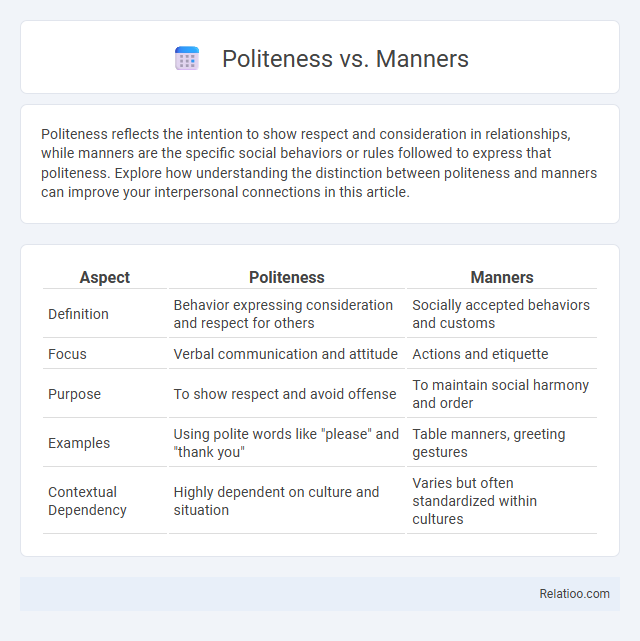Politeness reflects the intention to show respect and consideration in relationships, while manners are the specific social behaviors or rules followed to express that politeness. Explore how understanding the distinction between politeness and manners can improve your interpersonal connections in this article.
Table of Comparison
| Aspect | Politeness | Manners |
|---|---|---|
| Definition | Behavior expressing consideration and respect for others | Socially accepted behaviors and customs |
| Focus | Verbal communication and attitude | Actions and etiquette |
| Purpose | To show respect and avoid offense | To maintain social harmony and order |
| Examples | Using polite words like "please" and "thank you" | Table manners, greeting gestures |
| Contextual Dependency | Highly dependent on culture and situation | Varies but often standardized within cultures |
Understanding Politeness and Manners
Understanding politeness involves recognizing the social norms that guide respectful and considerate behavior, while manners refer to specific actions or customs that demonstrate this respect. Politeness is the underlying intention to make interactions pleasant and respectful, whereas manners are the tangible expressions of this intention, such as saying "please" and "thank you." Your ability to navigate both concepts effectively enhances social harmony and positive communication.
The Origins of Politeness
The origins of politeness trace back to early social structures where cooperation and respect were essential for group survival, evolving from basic gestures of consideration into complex social rules. Politeness differs from manners, which are specific behaviors learned through cultural norms, while politeness reflects the underlying intention to show respect and avoid offense. Your understanding of these distinctions enhances social interactions by recognizing that politeness is a deeper principle guiding the expression of good manners.
The Evolution of Manners Across Cultures
The evolution of manners across cultures demonstrates how social norms adapt to changing environments while reflecting core values of respect and consideration. Politeness serves as the overarching principle guiding behavior, whereas manners are the specific practices shaped by cultural contexts. Understanding these distinctions helps You navigate diverse social settings with sensitivity and grace.
Key Differences Between Politeness and Manners
Politeness refers to the social behavior that shows respect and consideration for others, often reflected in language and tone, while manners are the customary codes of conduct or etiquette governing specific social interactions. The key difference lies in politeness being an internal attitude or intent expressed outwardly, whereas manners are external actions shaped by cultural norms and rules. You can enhance your social interactions by understanding that politeness involves genuine respect, while manners focus on following established social conventions.
The Role of Social Context in Politeness
Politeness, manners, and etiquette each serve distinct functions influenced heavily by social context, shaping how behavior is perceived and interpreted. Social norms dictate which expressions of politeness are appropriate, guiding your interactions to align with cultural expectations and enhance mutual respect. Understanding these contextual cues allows you to navigate social situations effectively, balancing personal expression with communal harmony.
How Manners Reflect Societal Values
Manners serve as the behavioral expressions of societal values, encapsulating respect, empathy, and cultural norms through everyday actions such as greetings, dining etiquette, and communication styles. Understanding manners helps You navigate social interactions by aligning your conduct with the expectations of your community, thus fostering harmony and mutual respect. The nuanced distinction between politeness and manners lies in manners being the practical manifestation of politeness shaped by specific cultural contexts.
The Psychology Behind Politeness
Politeness involves cognitive and emotional processes that manage social harmony by regulating your behavior to show respect and consideration for others. Psychology reveals that practicing politeness activates empathy and theory of mind, allowing you to anticipate and respond to others' feelings appropriately. Understanding these psychological mechanisms enhances your social interactions, fostering positive relationships through intentional polite expressions.
Challenges in Teaching Manners and Politeness
Teaching manners and politeness presents challenges due to cultural variations and subjective interpretations of social norms, which can lead to misunderstandings in diverse classrooms. Students may struggle to internalize polite behavior when subtle cues differ by context, requiring educators to balance explicit instruction with modeling respectful interactions. Effective teaching strategies must incorporate empathy, cultural sensitivity, and practical examples to help learners navigate these complexities and develop genuine social competence.
Contemporary Examples of Politeness and Manners
Politeness involves showing respect and consideration through language and behavior, such as saying "please" and "thank you," while manners refer more broadly to social behaviors like table etiquette or punctuality. Contemporary examples of politeness include using inclusive language and active listening during virtual meetings, whereas manners are demonstrated by habits like timely email responses and phone etiquette. Your ability to navigate both politeness and manners influences social interactions and professional relationships in today's digital and face-to-face environments.
The Lasting Impact of Politeness and Manners
Politeness and manners shape social interactions by fostering respect and positive communication, with politeness emphasizing considerate language and manners focusing on customary behaviors. The lasting impact of politeness and manners is evident in how they build trust, strengthen relationships, and create a harmonious environment. Your consistent practice of these qualities can leave a memorable impression that promotes goodwill and mutual understanding.

Infographic: Politeness vs Manners
 relatioo.com
relatioo.com